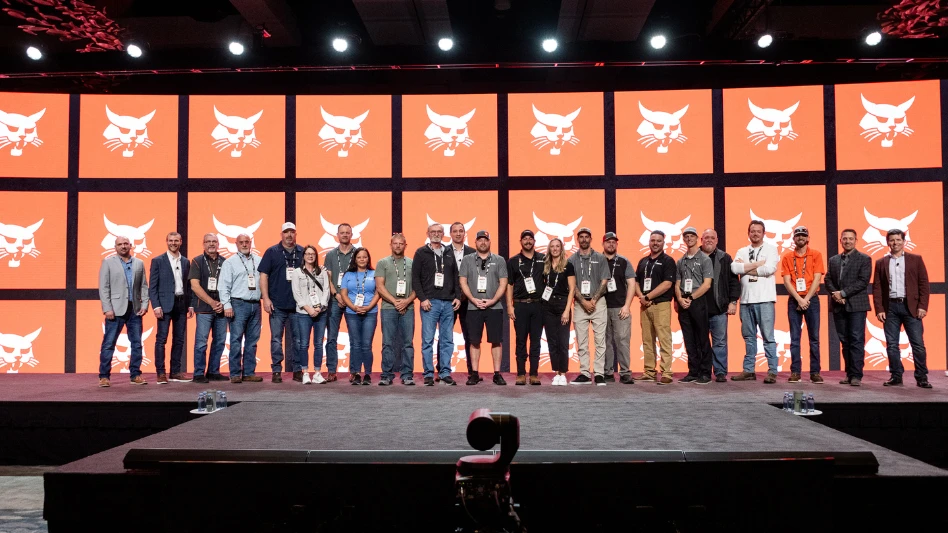The services a landscape company provides and to whom they provide them can weigh heavily on how a firm will fare in any one year. Advancements in technology, economic conditions, regulations and Mother Nature all will play a role in whether or not a contractor surges ahead, holds steady or loses ground in 2007.
For an outlook on service trends in the coming year, Lawn & Landscape talked with a sampling of suppliers, contractors and consultants. Here’s what they had to say about the different segments of the green industry.
|
|
SERVICE NO. 1 – MAINTENANCE. Considering the slow down in the real estate market, maintenance is the business to be in this year, according to Ed Laflamme, president of Grass Roots Consulting, Wilton, Conn. “If you’re not offering maintenance, you should be,” he says, explaining that it’s one of the industry services that’s best positioned for growth during a possible downturn. Laflamme also says a trend toward full-service firms will continue through 2007, as companies that are primarily design/build may move more into maintenance to insulate themselves when new home building slows. “Companies will realize they don’t have as much construction work, so they will do more work for the customers they have,” he says.
It’s not a surprising prediction, considering the average cost of acquiring a new client is $257, according to industry consultant Judy Guido of Guido & Associates, Moorpark, Calif.
In addition to becoming more costly to acquire, customers are becoming more particular, says Tom Heaviland, president of Heaviland Enterprises, Vista, Calif. “Customers are becoming more demanding and their expectations are higher,” he says. “On the commercial side, they have a lot of choices and they know they can get pretty consistent quality, so they can demand it. We saw that quite a bit last year and expect it will continue this year.”
Heaviland also sees partnering to provide other services as an opportunity that contractors soon will have to seize. “They are looking for you to help broker other services or be more of a concierge,” he says. “Maybe you don’t do parking lot sweeping for them, but you line that up. Not all of them are going to be expecting it, but as contractors we can start to take the lead and do our part.”
Contractors in commercial maintenance also must keep an eye on consolidations among firms that provide property management and real estate services, Heaviland says, pointing to commercial real estate services giant CB Richard Ellis’s agreement to acquire Trammell Crow Co. for an estimated $2.2 billion late last year. “If you do a lot of commercial work, you could lose a big chunk of your portfolio if it gets gobbled up,” he says.
Those types of transactions also can affect contractors in the commercial snow business. Snow contractors with residential customers or per-push agreements face another unknown in 2007 and every year: the weather. “If it doesn’t snow it doesn’t matter how many customers you have,” says Roger Meyers of American Beauty Landscape, Boardman, Ohio.
SERVICE NO. 2 – LAWN CARE. Like maintenance companies, lawn care firms are analyzing the cost to acquire a client and will continue to focus on retention and add-ons in 2007, says Jim Fetter, lawn and landscape regional manager for Bayer Environmental Science, Research Triangle Park, N.C.
“We’re seeing more emphasis on retention rather than on trying to grab new customers,” Fetter says. “The industry is taking a harder look at the lifetime value of a good customer.”
This year, public health issues also will give LCOs the opportunity to increase their sales of value-added services and to position themselves as more than just companies that take care of peoples’ lawns.
“We’re at a crossroads of positioning the industry and individual businesses in a positive light,” Fetter says. Consumers are facing a number of high-profile, “emotional” pest problems right now – with fire ants a perennial problem in the South, the emerald ash borer invading states across the North and mosquito-related concerns like West Nile virus nationwide. These are the services that will create opportunities for LCOs, Fetter says.
The residential market continues to be a higher margin one for lawn care firms, Fetter says, noting commercial property managers’ tight budgets won’t go away any time soon.
SERVICE NO. 3 – LANDSCAPE
DESIGN/BUILD. Encouraged by Home & Garden Television, makeover television shows and a robust economy in recent years, the “outdoor living” trend is alive and well – a good sign for the landscape design/build segment despite the fact that the housing cool down is expected to trickle down to landscape construction.
A home design trends study conducted in 2006 by the American Institute of Architects indicated that two-thirds of residential architects saw an increase in outdoor living spaces, including decks, patios and outdoor kitchens – a 17 percent boost over 2005. Likewise, 56 percent of architects reported a rise in upscale landscaping and 5 percent saw an increase in formal lot boundaries. One factor driving this trend is smaller lot sizes, according to the AIA’s Chief Economist Kermit Baker. “It makes sense that with a smaller lot you need to use it differently and improve it better than if you have a big property. “That’s why we’re seeing an increase in formal lot boundaries and upscale landscaping,” he says, noting the trend should continue through 2007. “In terms of ‘07 and beyond, it’s hard to think these trends are going to turn on a dime.”
But what about the real estate slow down? “I don’t think the outdoor living trend will be greatly affected,” Baker says. “You may not see as many $40,000 or $50,000 outdoor kitchens, as those are probably discretionary items that were made possible by the hot real estate market, but the general focus on people improving their properties will not be hit hard by the cool down.”
Piggy-backing on the success of the design/build segment and the outdoor living trend are specialty services like outdoor lighting and water features. “Consumers are definitely becoming more aware of lighting as every year goes by from a lot of the trends in outdoor living,” says Mike Southard, director of landscape lighting sales for Kichler Lighting, Cleveland. “As you spend more money on the outside, it becomes more important to light it.”
Lighting, water features and outdoor kitchens are several of the boom areas Guido forecasts for the next three to five years, particularly in terms of landscape renovation, often completed in phases, in middle- and upper-middle-class America. She points to the “exterior living” phenomenon as evidence – and even encourages contractors to start using the language that represents this trend. “Stop saying ‘properties’ or ‘yards’ and start saying exterior spaces and rooms,” she says. Guido also foresees a trend toward consumers requesting outdoor furniture and accessories from their landscape designers, and she advises contractors to start considering “strategic partnerships” with such suppliers.
SERVICE NO. 4 – IRRIGATION. Irrigation contractors are likely to see a lively year, as water conservation continues to be an important issue and several national initiatives drive home the point. Of course, external forces play a big role in irrigation. “If it’s a year of a lot of water restrictions and drought it will obviously affect the industry,” says Dave Johnson, director of corporate marketing for Rain Bird, Tucson, Ariz.
On the residential side, the Environmental Protection Agency’s WaterSense program is underway. WaterSense, a consumer labeling initiative, will help homeowners select water-efficient products and services. The EPA signed partnerships with the Professional Landcare Network (PLANET) and the Irrigation Association for certification programs last fall and hopes to roll out the product labeling effort for controllers in 2007 and drip irrigation products in 2008.
“I think the EPA’s and other agencies’ work on water conservation reflects people’s greater awareness of water issues,” Johnson says. “Contractors are going to start addressing that in how they deal with customers.”
In commercial applications, awareness of the Leadership in Energy and Environmental Design (LEED) standard, set by the U.S. Green Building Council to encourage environmental consciousness in the building industry, will contribute to the growth of irrigation systems being installed and upgraded nationwide. Five out of the 69 points that help determine whether a new building is deemed LEED-compliant relate to irrigation. Evidence that the green building concept is taking root: The effort’s associated trade show, Greenbuild, was named one of Tradeshow Week’s fastest growing shows in the U.S. and Canada.
One economic indicator that the irrigation segment, like most others, monitors carefully is new home starts, which are expected to plummet in 2007. However, it might not be a bad thing for irrigation contractors, Johnson notes. “People may look to upgrade the home they’re staying in or look at installing a new system in their current home,” he says. This outcome would boost the need for system auditing on the residential level, Johnson notes. “It may become a bigger service as people get interested in how much their current system uses and how they can upgrade.”
A growing focus on “smart” ET-based or weather-based controllers comes thanks to technological advancements that make them more affordable, support from water agencies and grassroots industry efforts, like the IA dubbing July as Smart Irrigation Month. “The focus on climate-based controllers is getting to be more of a hot topic to address residential systems,” Johnson says. Drip irrigation, too, is becoming more prevalent. “More contractors outside the traditional drip areas are trying to get into it and understand what it means,” he says. “Some contractors may be intimidated because parts and pieces are different from what they’re used to, but once they get in there and they recognize the water savings for their customers, they’re usually into it.”

Explore the January 2007 Issue
Check out more from this issue and find your next story to read.
Latest from Lawn & Landscape
- North by Northwest's charitable act for the Ronald McDonald House Charities
- Coxreels expands V-100 Series product line
- Landscape Workshop expands with 2 acquisitions
- Wilson360 adds Daniel Grange as new consultant
- Batman and business
- CH Products releases new tree stabilizer
- Savannah Bananas founder Jesse Cole to speak at Equip Exposition
- Catch up on last year's Benchmarking report






